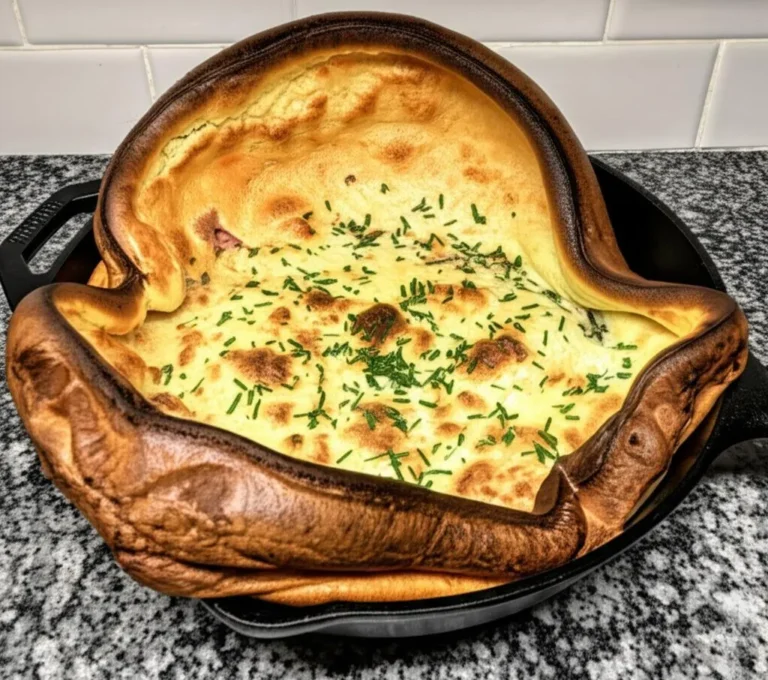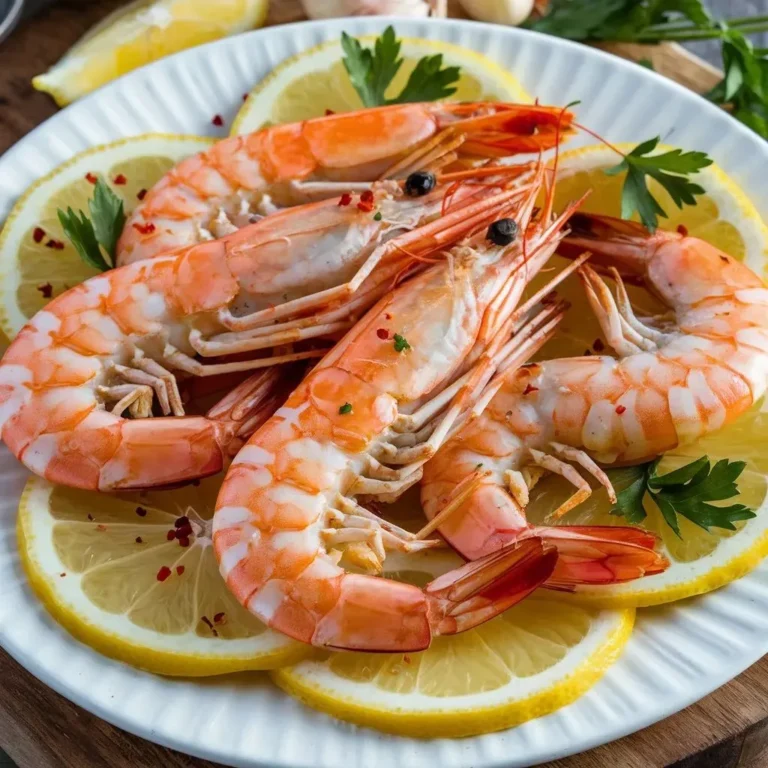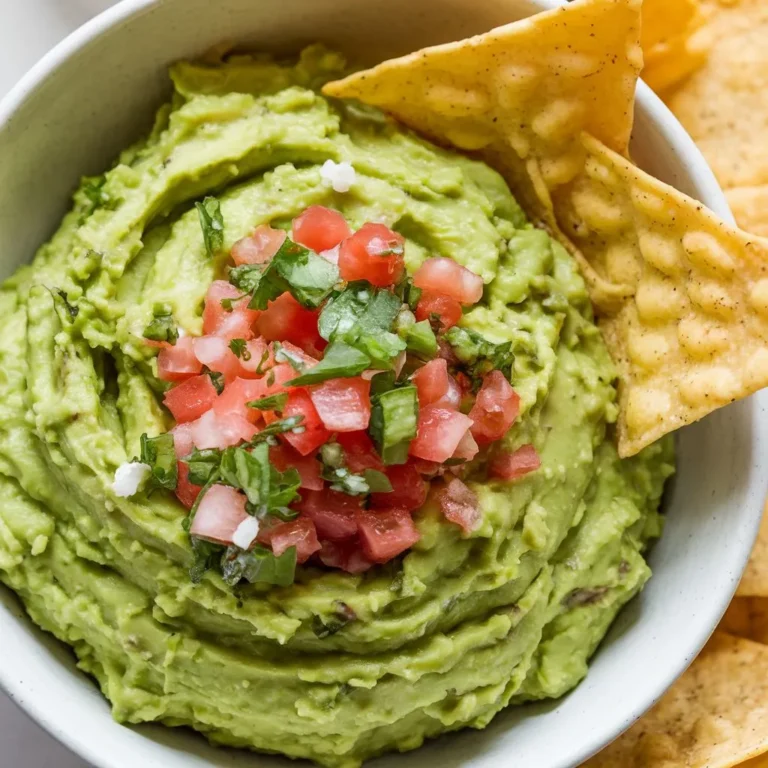Discover the rich flavors of Classic German Dishes in our list of the 10 most popular German foods to savor! From hearty sausages like Bratwurst to classic dishes like Sauerbraten and sweet treats like Black Forest Cake, explore traditional German cuisine that’s loved worldwide. Perfect for foodies and travelers alike, this guide will inspire your next culinary adventure.
1. Currywurst Recipe

Overview of Currywurst
Currywurst is a popular German fast food dish that consists of a sausage, typically bratwurst, served with a sauce made from curry ketchup. This dish was invented in 1949 by Herta Heuwer in West Berlin, where she began selling it from a food stand. Today, it is estimated that around 800 million currywurst are consumed annually in Germany, with 70 million of those in Berlin alone.
Cultural Significance
Currywurst is considered an iconic street food in Germany, akin to the hot dog in the United States. It is widely available at snack bars (Schnellimbisse) and has become a staple at fairs and markets throughout the country. The dish reflects post-war culinary innovation, combining local ingredients with influences from British soldiers who introduced curry powder and ketchup to Germany after World War II. In summary, currywurst not only serves as a beloved snack but also embodies a significant piece of German culinary history and culture.
Ingredients
For the Sausage:
- 4-6 Bratwursts or Bockwursts
For the Curry Ketchup Sauce:
- 1 cup tomato ketchup
- 2 tablespoons curry powder (adjust to taste)
- 1 tablespoon Worcestershire sauce
- 1 tablespoon apple cider vinegar
- 1 tablespoon brown sugar
- 1 teaspoon onion powder
- 1/4 teaspoon cayenne pepper (optional, for heat)
- 1/4 teaspoon baking soda (optional, for texture)
Instructions
- Cook the Sausages:
- Grill or pan-fry the bratwursts until they are browned and cooked through. This usually takes about 10-15 minutes, turning occasionally to ensure even cooking.
- Prepare the Curry Ketchup Sauce:
- In a saucepan, combine the ketchup, curry powder, Worcestershire sauce, apple cider vinegar, brown sugar, onion powder, and cayenne pepper.
- Heat over medium heat, stirring occasionally until the mixture is warmed through and well combined (about 5 minutes).
- Serve:
- Slice the cooked sausages into bite-sized pieces and place them on a plate.
- Generously drizzle the curry ketchup sauce over the sausages.
- Optionally, sprinkle additional curry powder on top for extra flavor.
- Accompaniments:
- Serve with crispy fries or soft bread rolls (Brötchen) on the side for a complete meal.
Enjoy your homemade currywurst as a satisfying snack or light meal!
2. Rouladen Recipe
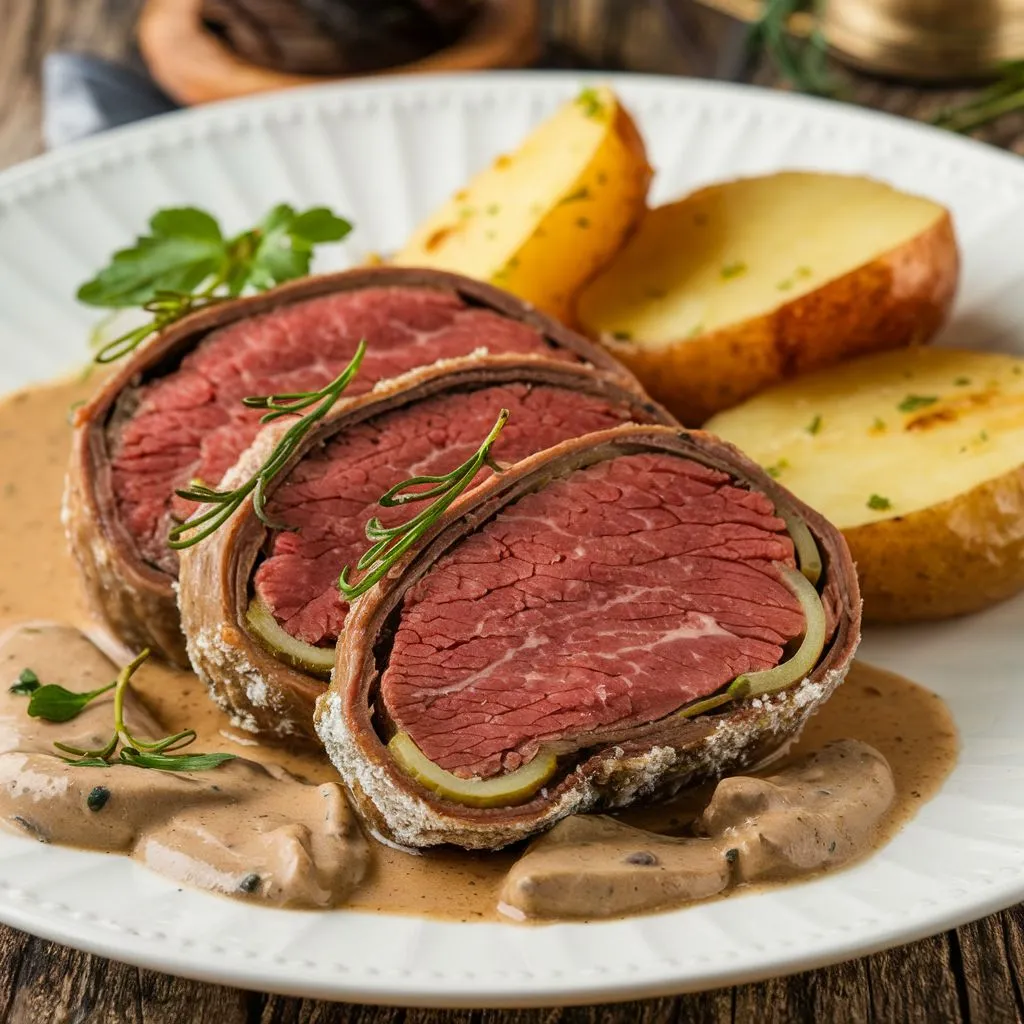
Origins and Etymology
The term “roulade” derives from the French word “rouler,” meaning “to roll,” which aptly describes the dish’s preparation method. While the precise origins of roulade are somewhat unclear, it is widely recognized that similar meat rolls have been made across various cultures in Europe. The dish took on its distinctive character in Germany, where it became a staple of home cooking and special occasions.
Historical Development
Rouladen is believed to have emerged in Germany as a way to utilize less expensive cuts of meat. By rolling thin slices of beef around flavorful fillings such as mustard, bacon, onions, and pickles, cooks could transform tougher cuts into tender and savory meals. This practice not only maximized the use of available resources but also highlighted the German knack for practical cooking innovations. Historically, roulade was considered a special dish, often reserved for Sundays or festive gatherings. It became particularly popular in the 19th and 20th centuries as beef became more accessible to the general population. The dish’s comforting nature made it especially favored during the colder months, symbolizing warmth and family togetherness.
Regional Variations
Across Germany, roulade recipes can vary significantly by region, with different fillings and preparation methods reflecting local tastes. While the classic version typically includes bacon and pickles, some variations incorporate additional ingredients like minced meat or different types of vegetables. In addition to its popularity in Germany, roulade has also found its way into neighboring countries like Poland and the Czech Republic, where similar dishes are known by different names.
Cultural Significance
Today, roulade is more than just a meal; it embodies a connection to German heritage and culinary traditions. It is often served during family gatherings, holidays, and special occasions like Christmas Eve, reinforcing its status as a comfort food that evokes nostalgia for many Germans. In summary, rouladen represents a blend of practicality, tradition, and community spirit in German cuisine. Its evolution from a special occasion dish to an everyday favorite illustrates how food can adapt over time while retaining its cultural roots.
Ingredients
For the Rouladen:
- 2-3 lbs top round beef (sliced into thin sheets, about 1/4 inch thick)
- 1/3 cup German mustard (or Dijon)
- 8 slices bacon
- 8 dill pickles (sliced lengthwise)
- 1 large onion (thinly sliced)
- Salt and pepper (to taste)
- Toothpicks or kitchen twine
For the Gravy:
- 2 tablespoons butter or oil
- 1 medium onion (chopped)
- 1 carrot (chopped)
- 1 celery stalk (chopped)
- 2 cups beef broth
- 1 cup dry red wine
- 1 tablespoon tomato paste
- 1 bay leaf
- Salt and pepper (to taste)
Instructions
- Prepare the Beef:
- Lay out each slice of beef on a clean surface. Lightly pound them if necessary to ensure they are even.
- Spread a thin layer of mustard over each slice and season with salt and pepper.
- Add Fillings:
- Place a slice of bacon on each beef slice, followed by a few pieces of pickle and some onion slices.
- Roll up each slice tightly from one end to the other and secure with toothpicks or twine.
- Brown the Rouladen:
- In a large Dutch oven or heavy pot, heat the butter or oil over medium-high heat.
- Add the roulade rolls and brown them on all sides for about 5 minutes. Remove them from the pot and set aside.
- Make the Gravy:
- In the same pot, add chopped onion, carrot, and celery. Sauté until softened, about 5 minutes.
- Stir in the tomato paste, then pour in the red wine, scraping up any browned bits from the bottom of the pot.
- Add the beef broth and bay leaf. Bring to a simmer.
- Braise the Rouladen:
- Return the browned roulade to the pot, ensuring they are mostly submerged in the liquid.
- Cover with a lid and simmer on low heat for about 90 minutes to 2 hours, until the meat is fork-tender.
- Serve:
- Once cooked, remove the roulade from the pot and let them rest for a few minutes.
- Strain the gravy if desired, then return it to the pot to thicken if necessary. Adjust seasoning with salt and pepper.
- Serve the roulades with gravy poured over them, alongside traditional sides like spaetzle or boiled potatoes.
Enjoy your homemade roulade, a hearty dish that showcases traditional German flavors!
3. Spätzle Recipe
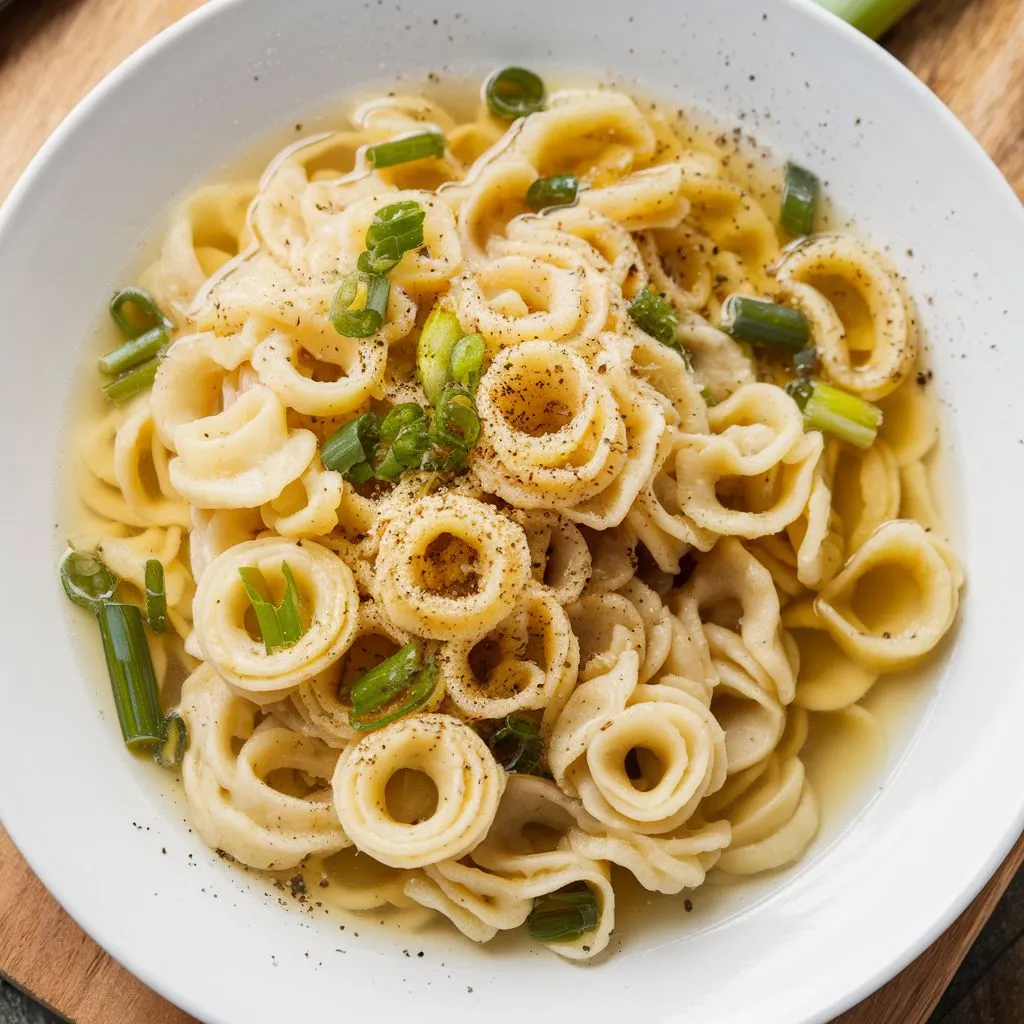
Spätzle, a beloved German dish, has a rich history that reflects its cultural significance and culinary evolution over the years.
Historical Background
The origins of spätzle can be traced back to the Swabian region of Germany, with references to similar egg noodles appearing as early as the 18th century. The name “spätzle” translates to “little sparrows” in German, which is thought to describe the irregular shapes of the noodles when they are formed and cooked. Historically, spätzle was created as a way to utilize simple ingredients—primarily flour, eggs, and water—making it an accessible dish for many households. It became particularly popular during times when meals needed to be hearty yet economical.
Evolution and Variations
Over time, spätzle has evolved into various forms and recipes across different regions. While traditional spätzle is made with just flour, eggs, and water or milk, modern variations may include additional ingredients like nutmeg or cheese (as in Käsespätzle), which is a popular dish where spätzle is layered with cheese and onions. Spätzle-making techniques have also diversified. Traditionally, the dough is pressed through a spätzle maker or scraped off a board into boiling water. Today, various tools such as colanders or specialized presses are used to create the characteristic shape of the noodles.
Cultural Significance
Spätzle holds a special place in German cuisine, often served as a side dish accompanying rich meat dishes like Rouladen, goulash, or schnitzel. Its versatility allows it to be enjoyed in numerous ways, from being sautéed in butter to being served in soups. In festive settings, spätzle often appears at family gatherings and celebrations, symbolizing comfort and togetherness. Its enduring popularity attests to its status as a staple of German culinary tradition. In summary, spätzle’s history reflects its humble beginnings as a practical dish that has grown into a cherished component of German cuisine, celebrated for its simplicity and adaptability.
Ingredients
- 2 cups all-purpose flour
- 1 ½ teaspoons salt
- ¼ teaspoon ground nutmeg (optional, for flavor)
- 4 large eggs
- ½ cup milk or water (adjust as needed for consistency)
- Butter (for serving)
Instructions
- Prepare the Dough:
- In a large bowl, combine the flour, salt, and nutmeg (if using).
- In another bowl, whisk the eggs and then add the milk or water.
- Gradually mix the wet ingredients into the dry ingredients until you achieve a thick batter that is slightly runny but not too liquid. The consistency should resemble a thick pancake batter.
- Rest the Dough:
- Let the batter rest for about 10-15 minutes. This helps improve the texture of the spätzle.
- Boil Water:
- Bring a large pot of salted water to a rolling boil. The water should taste like ocean water.
- Shape and Cook Spätzle:
- Press or scrape small amounts of batter into the boiling water using a spätzle maker, colander, or a cutting board with a knife.
- Cook the spätzle for about 2-3 minutes, or until they float to the surface, indicating they are done.
- Use a slotted spoon to remove them from the water and transfer them to a colander.
- Serve:
- Toss the cooked spätzle with melted butter to prevent sticking.
- Serve warm as a side dish with your favorite meat dishes or sauces.
Tips
- For added flavor, sauté cooked spätzle in butter until golden brown before serving.
- Mix sautéed onions or herbs into the batter for extra taste.
Enjoy your homemade spätzle, a delightful addition to any meal!
4. Bratwurst Recipe

Bratwurst, a quintessential German sausage, has a rich history that reflects both culinary tradition and regional diversity.
Etymology and Origins
The term “bratwurst” is derived from the Old High German word “Brät,” which refers to finely chopped meat, combined with “Wurst,” meaning sausage. The word is also associated with the German verb “braten,” which means to fry or grill, highlighting the common cooking methods for this sausage. Historical references to bratwurst date back to at least 1404, indicating its long-standing presence in German cuisine.
Historical Development
Bratwurst originated in Germany, with various regions developing their unique recipes and styles. The earliest forms of bratwurst were made primarily from pork, but over time, variations emerged that included beef, veal, and even lamb. Each region has its specific ingredients and seasonings; for example:
- Nürnberger Bratwurst: A smaller sausage made with pork and marjoram.
- Thüringer Rostbratwurst: A longer sausage seasoned with cumin and garlic.
These regional differences contribute to the vast array of bratwurst varieties available today, with estimates suggesting there are over 40 distinct types across Germany.
Culinary Significance
Bratwurst is typically grilled or pan-fried and served in various ways. It is commonly enjoyed in a bread roll with mustard or alongside traditional sides such as sauerkraut and potato salad. The popularity of bratwurst extends beyond Germany; it has become a staple at barbecues and festivals worldwide.
Modern Variations
In contemporary cuisine, bratwurst continues to evolve. While traditional recipes remain popular, modern interpretations may incorporate unique flavorings or be served in innovative dishes. One notable example is Currywurst, which features bratwurst served with a spicy curry ketchup sauce—a dish that gained fame in post-war Germany.
Conclusion
Bratwurst’s history illustrates its significance as more than just a sausage; it is a cultural icon that embodies regional pride and culinary heritage in Germany. Its adaptability and enduring popularity ensure that bratwurst remains a beloved dish both at home and around the world.
# Nürnberger Bratwurst
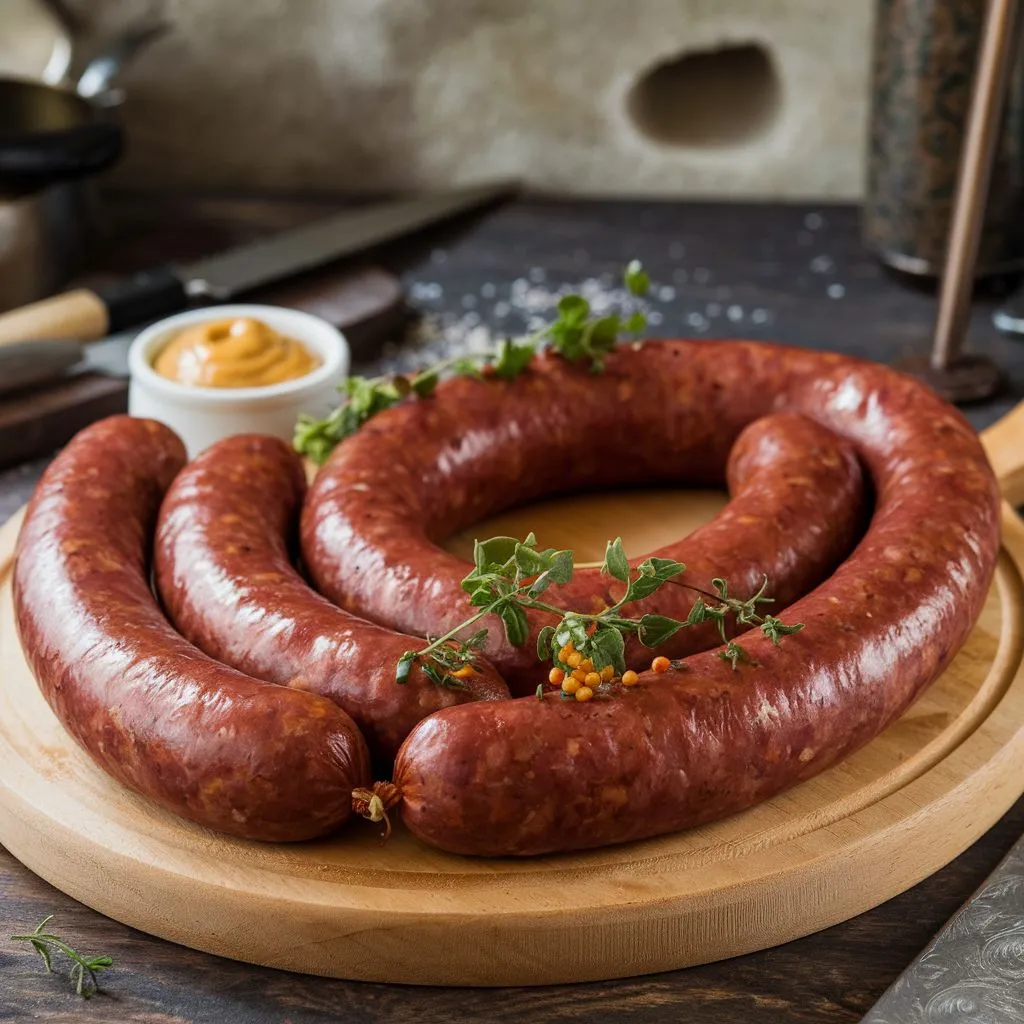
Nürnberger Bratwurst, originating from the city of Nuremberg in Germany, is a renowned type of sausage known for its distinct flavor and small size. This sausage has a rich history and is celebrated for its unique blend of spices and traditional preparation methods.
Historical Background
The Nürnberger Bratwurst dates back to the 15th century, making it one of the oldest types of bratwurst. The production of this sausage has been a significant part of Nuremberg’s culinary heritage, with the city being recognized for its high-quality sausages. In 2003, Nürnberger Bratwurst received Protected Geographical Indication (PGI) status, which helps preserve its traditional production methods and ensures that only sausages made in Nuremberg can bear the name.
Culinary Significance
Nürnberger Bratwurst is traditionally grilled over an open flame, giving it a distinctive smoky flavor. It is often served in groups of three (known as “Drei im Weggla”) in a bun with mustard or alongside sauerkraut. This practice highlights the communal aspect of enjoying food in German culture. The sausage’s popularity extends beyond Germany; it is enjoyed in various forms around the world, particularly at festivals and barbecues. Its unique taste and historical significance make it a cherished dish within German cuisine. In summary, Nürnberger Bratwurst represents a blend of tradition, quality ingredients, and regional pride, making it an iconic part of Germany’s culinary landscape.
Ingredients
For 1 kg of Nürnberger Bratwurst:
- 600 g pork shoulder or neck
- 400 g pork belly
- 20 g salt (about 3.5 tsp)
- 2 g black pepper (about 1/2 tsp)
- 1 g white pepper (about 1/4 tsp)
- 1 g mace (or nutmeg) (about 1/4 tsp)
- 1 g ginger (about 1/4 tsp)
- 4 g dried marjoram (about 1 tsp)
- Optional: Grated lemon zest for added flavor
- Natural hog casings (22-24 mm in diameter)
Instructions
- Prepare the Meat:
- Cut the pork shoulder and belly into small pieces suitable for your meat grinder.
- Chill the meat in the freezer for about 30 minutes to firm it up, making it easier to grind.
- Grind the Meat:
- Using a meat grinder fitted with a medium plate (5 mm), grind the chilled pork shoulder and belly together into a large mixing bowl.
- Mix the Spices:
- In a separate bowl, combine all the spices: salt, black pepper, white pepper, mace, ginger, and marjoram.
- Add the spice mixture to the ground meat and mix thoroughly by hand or with a stand mixer until well combined.
- Stuff the Sausage:
- Rinse the hog casings in cold water and soak them according to package instructions.
- Fit your sausage stuffer with the soaked casing and carefully fill it with the meat mixture, being careful not to overstuff. Tie off the ends of the casing securely.
- Twist sausages into links about 7-9 cm long (3-4 inches).
- Cook or Store:
- You can either cook the sausages immediately by grilling or frying them until browned and cooked through, or you can refrigerate them for later use.
- If storing, keep them in the refrigerator for up to a few days or freeze them for longer preservation.
- Serving Suggestions:
- Serve Nürnberger Bratwurst in a bun with mustard or alongside sauerkraut for an authentic experience.
Tips
- Ensure that all equipment and ingredients are kept cold during preparation to maintain texture and flavor.
- For best results, consume the sausages within a few days or freeze them for future meals.
Enjoy making your homemade Nürnberger Bratwurst, a delicious representation of German culinary tradition!
# Thüringer Rostbratwurst
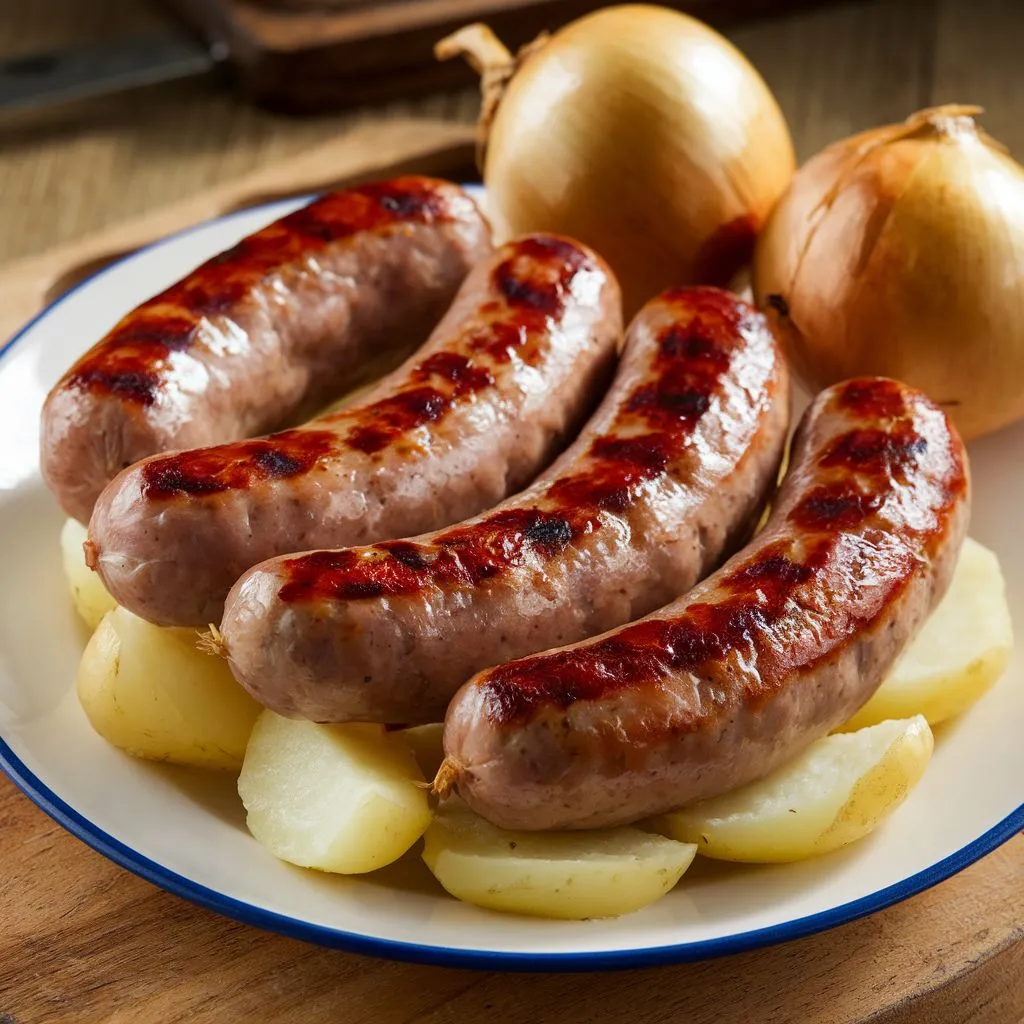
Overview of Thüringer Rostbratwurst
Thüringer Rostbratwurst is a traditional German sausage originating from the Thuringia region, known for its rich flavor and historical significance. The first documented reference to this sausage dates back to 1404, and it has been an integral part of Thuringian cuisine ever since. The oldest known recipe can be found in the Weimar State Archives, dating back to 1613, highlighting its long-standing heritage.
Culinary Significance
Thüringer Rostbratwurst is characterized by its robust flavor profile, primarily due to the use of marjoram and caraway seeds. It is traditionally served at outdoor barbecues and festivals, often accompanied by mustard and fresh bread. In 2003, it received Protected Geographical Indication (PGI) status, which helps preserve its traditional production methods and ensures that only sausages made in Thuringia can be labeled as Thüringer Rostbratwurst.
Modern Variations
While the traditional recipe remains popular, modern interpretations may include variations in spices or additional ingredients like milk or eggs for moisture. The sausage continues to be a staple in German cuisine, enjoyed not only in Thuringia but also throughout Germany and beyond.
In summary, Thüringer Rostbratwurst represents a blend of history, tradition, and regional pride, making it a beloved dish within German culinary culture. Its enduring popularity speaks to its quality and the craftsmanship involved in its production.
Ingredients
For 1 kg of Thüringer Rostbratwurst:
- 750 g pork shoulder (or pork jowls)
- 250 g pork belly
- 18 g salt (about 3 tsp)
- 2 g white pepper (about 1 tsp)
- 2 g whole caraway seeds (about 1 tsp)
- 0.5 g mace (about 1/4 tsp)
- 2 g dried marjoram (about 1 tsp)
- 1 clove garlic (smashed)
- Optional: Zest of half a lemon for added flavor
- Natural hog or sheep casings (28 mm in diameter)
Instructions
- Prepare the Meat:
- Cut the pork shoulder and belly into small chunks suitable for grinding. Chill the meat in the freezer for about 30 minutes to firm it up, making it easier to grind.
- Grind the Meat:
- Using a meat grinder fitted with a medium plate (10 mm), grind the chilled pork shoulder and belly together into a large mixing bowl.
- Mix the Spices:
- In a separate bowl, combine all the spices: salt, white pepper, caraway seeds, mace, marjoram, and garlic.
- Add the spice mixture to the ground meat and mix thoroughly by hand or with a stand mixer until well combined.
- Stuff the Sausage:
- Rinse the hog or sheep casings in cold water and soak them according to package instructions.
- Fit your sausage stuffer with the soaked casing and carefully fill it with the meat mixture, being careful not to overstuff. Tie off the ends of the casing securely.
- Twist sausages into links about 20 cm long (8 inches).
- Refrigerate:
- Place the stuffed sausages in the refrigerator for at least a few hours to allow flavors to meld.
- Cook and Serve:
- Grill or fry the sausages until browned and cooked through, about 5-8 minutes on each side.
- Serve hot with mustard and fresh bread or alongside traditional sides like sauerkraut.
Tips
- Ensure that all equipment and ingredients are kept cold during preparation to maintain texture and flavor.
- For best results, consume the sausages within a few days or freeze them for future meals.
Enjoy your homemade Thüringer Rostbratwurst, a delicious representation of traditional German sausage-making!
5. Sauerbraten recipe
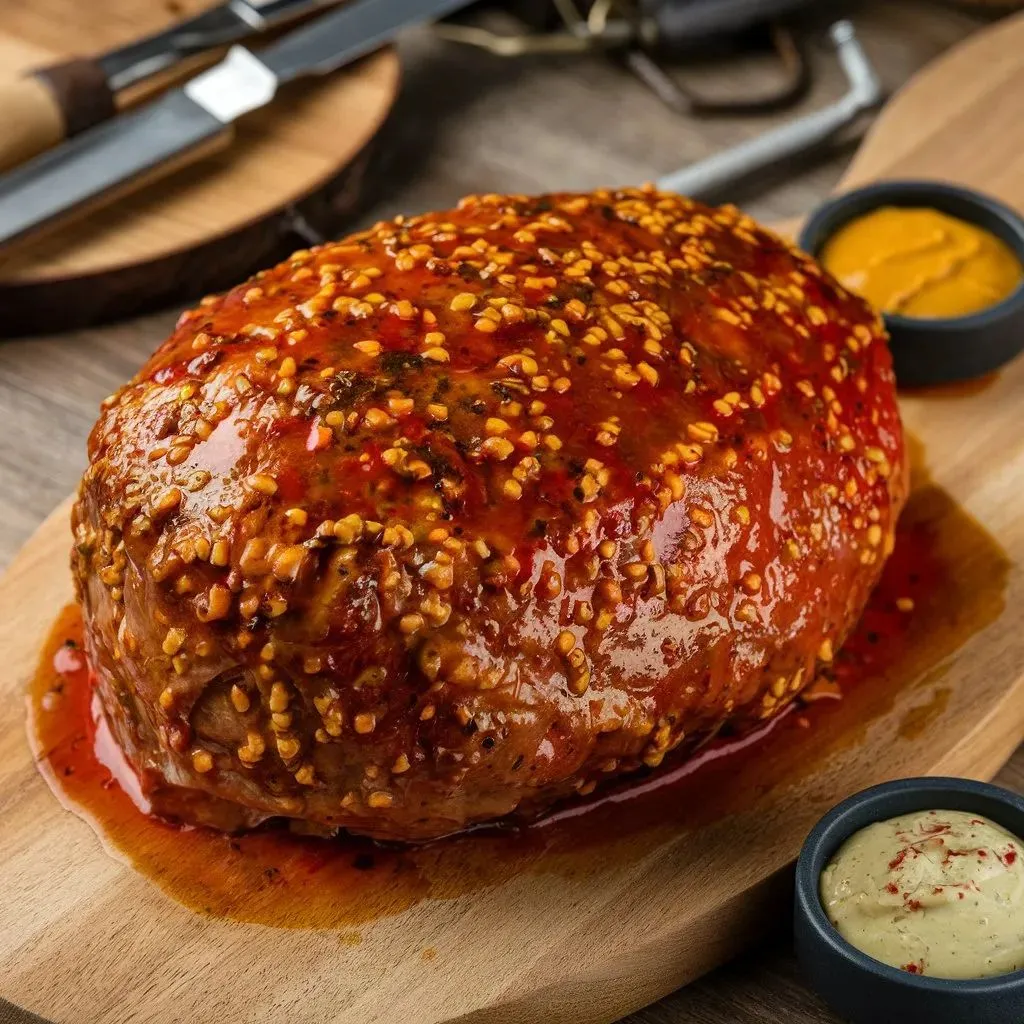
Sauerbraten, often regarded as Germany’s national dish, has a rich history and etymology that reflect its significance in German cuisine.
Origins and Etymology and Conclusion
Origins
The origins of Sauerbraten can be traced back over 2,000 years, with early practices of marinating meat for preservation. It is believed that the Romans used vinegar and wine to preserve meat, which was essential for transportation to various settlements across their empire. The dish became more defined in the Middle Ages when marinating meat was common to enhance flavor and tenderness. Historical anecdotes suggest that even Julius Caesar had a version of Sauerbraten sent to him while on military campaigns, highlighting its long-standing presence in culinary traditions. Sauerbraten was traditionally made with horse meat, but over time, beef has become the most common choice. Various regional adaptations exist throughout Germany, with significant variations in ingredients and preparation methods. For example, the Rheinischer Sauerbraten from the Rhineland is known for its slightly sweet sauce made with raisins.
Etymology
The term “Sauerbraten” literally translates to “sour roast” in German. This name reflects the dish’s characteristic marinade, which typically includes vinegar and wine, imparting a sour flavor to the meat. The word “Sauer” denotes the acidity of these ingredients, while “brazen” refers to the roasting or braising method used in cooking the meat. The balance of sweet and sour flavors is a hallmark of Sauerbraten, achieved by incorporating sweet elements like sugar or ginger snap cookies into the gravy. This combination not only enhances the taste but also serves to tenderize tougher cuts of meat through prolonged marination.
Conclusion
Sauerbraten stands as a testament to Germany’s culinary heritage, representing a blend of historical preservation techniques and regional flavors. Its enduring popularity is attributed to its comforting nature and the tradition of family recipes passed down through generations. Today, it remains a beloved dish enjoyed during festive occasions and family gatherings alike.
Ingredients
- 3 to 4 pounds of beef rump roast
- 2 large onions, chopped
- 2 large carrots, chopped
- 4-5 cloves garlic, minced
- 1 cup red wine vinegar (can substitute with cider vinegar)
- 2 cups red wine
- 1 ½ cups water
- 1 tablespoon salt
- 10 whole black peppercorns, cracked
- 1 tablespoon sugar (or honey)
- 2 sprigs rosemary
- 2 sprigs thyme
- 10 whole cloves
- 2 bay leaves
- ¼ cup golden raisins (optional)
For Cooking
- ½ cup all-purpose flour (for dredging)
- ¼ cup vegetable oil (or lard)
- 10 ginger snap cookies, crushed (for thickening the gravy)
Instructions
Step 1: Marinate the Beef
- In a large pot, combine the chopped onions, carrots, garlic, red wine vinegar, red wine, water, salt, peppercorns, sugar, rosemary, thyme, cloves, bay leaves, and optional raisins.
- Bring the mixture to a boil over medium heat, then reduce the heat and simmer for about 10 minutes. Allow it to cool completely.
- Once cooled, place the beef roast in the marinade. Cover and refrigerate for at least 4 days (up to 10 days for stronger flavor), turning the meat occasionally.
Step 2: Prepare for Cooking
- After marinating, remove the beef from the marinade and pat it dry with paper towels. Reserve the marinade.
- Dredge the beef in flour, shaking off any excess.
Step 3: Sear the Beef
- In a large Dutch oven or heavy pot, heat the vegetable oil over medium-high heat.
- Sear the beef on all sides until browned (about 2 minutes per side).
Step 4: Braise the Beef
- Once seared, return the reserved marinade to the pot with the beef.
- Bring to a boil over high heat, then cover and reduce to medium-low heat.
- Simmer for about 2 to 2½ hours until the meat is tender. Alternatively, you can transfer the covered Dutch oven to an oven preheated to 350°F (175°C) for the same duration.
Step 5: Make the Gravy
- After cooking, remove the beef from the pot and let it rest on a cutting board for about 10 minutes.
- Strain the cooking liquid into a saucepan, discarding solids.
- Add crushed ginger snap cookies to the strained liquid and simmer over medium-low heat for about 10 minutes until thickened into a gravy.
Step 6: Serve
- Slice the Sauerbraten thinly and serve it with hot gravy poured over it.
- This dish is traditionally accompanied by red cabbage and potato dumplings.
Enjoy your homemade Sauerbraten! The combination of sweet and sour flavors along with tender beef makes this dish a classic favorite in German cuisine.
6. Gulasch recipe
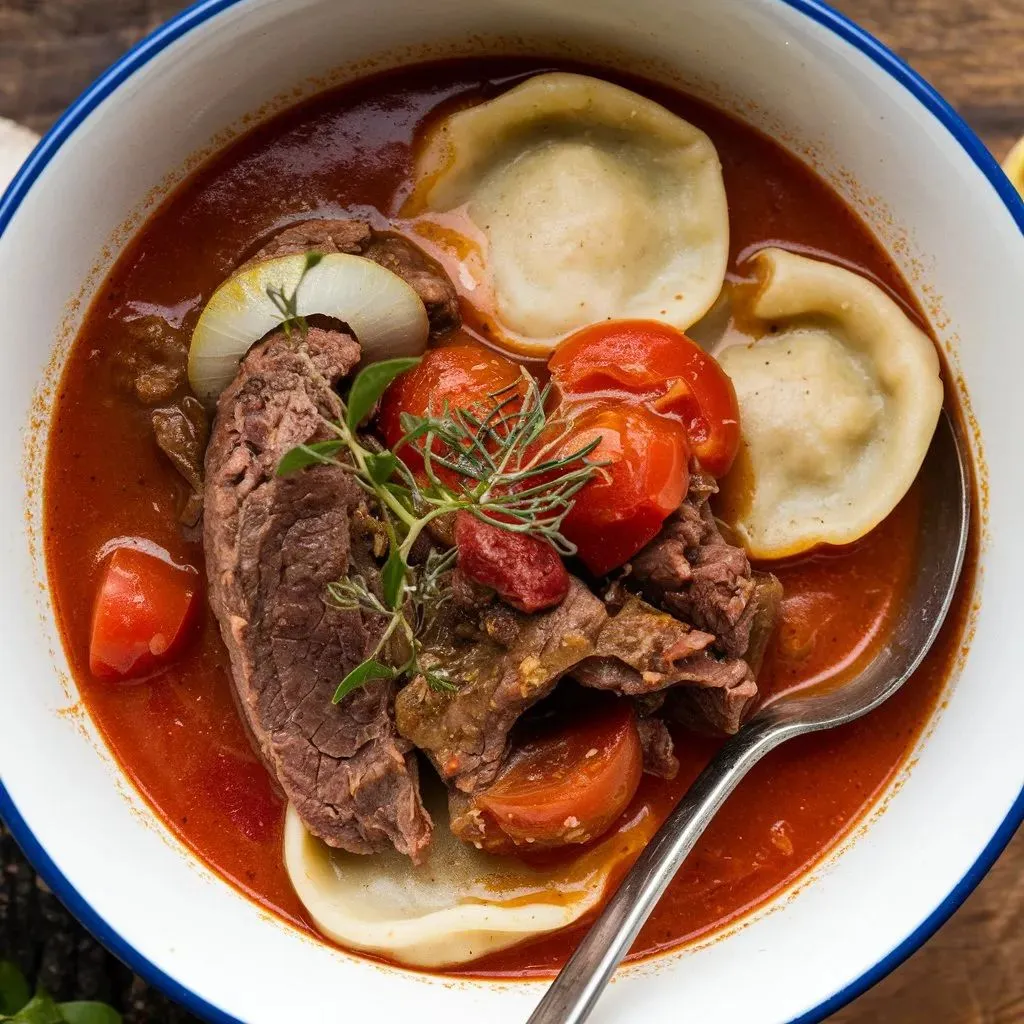
Origins and Etymology and Conclusion
Goulash, a hearty and flavorful stew, has a rich history and etymology that reflect its deep roots in Hungarian culture.
Origins
Goulash originated among the Magyar shepherds of the Great Hungarian Plain in the 9th century. These herdsmen, known as gulyás, would cook a simple stew using readily available ingredients such as meat (often beef), onions, and spices. They prepared this dish in large cauldrons over an open fire, making it a practical meal that could be easily transported and reheated during their long periods away from home
Initially, goulash was a basic dish, but it began to evolve significantly in the 16th century with the introduction of paprika to Hungary. This spice, brought from the Americas by the Ottoman Turks, transformed goulash into the vibrant dish we know today. Paprika not only added flavor but also gave goulash its characteristic red color. Over time, variations emerged that included additional ingredients like potatoes and carrots
By the 19th century, goulash had become emblematic of Hungarian national identity, particularly during the Austro-Hungarian Empire. As Hungary sought to establish its cultural distinctiveness, traditional dishes like goulash gained prominence across the region, leading to variations such as the Austrian Gulasch, which is typically thicker and more stew-like.
Etymology
The name “goulash” derives from the Hungarian word gulyás, which means “herdsman” or “cowboy.” The term originally referred to the herdsmen who prepared this dish. The word gulyas translates to “herd of cattle,” highlighting the connection between the dish and its origins among cattle herders
Over time, gulyás evolved from simply denoting a herdsman to referring specifically to a meat dish prepared by these herders. In medieval times, Hungarian herdsmen utilized every part of the animal they could find due to scarcity, making goulash a resourceful and economical meal.
Conclusion
Goulash stands as a symbol of Hungarian culinary heritage, reflecting both historical practices and cultural identity. Its evolution from a simple shepherd’s stew to a beloved national dish showcases how regional ingredients and cooking methods can shape a cuisine over centuries. Today, goulash remains a staple in Hungarian households and is celebrated worldwide for its comforting flavors and hearty nature.
Ingredients
- 6 strips of chopped bacon
- 2 pounds beef shanks or chuck, cut into 1-inch cubes
- 2 medium yellow onions, diced
- 3 cloves garlic, minced
- 1 red bell pepper, diced
- 1 banana or cubanelle pepper, sliced
- 3 medium tomatoes, diced (or 1 can of diced tomatoes)
- 1 ½ teaspoons ground cumin
- 1 tablespoon sweet Hungarian paprika
- 1 cup red wine
- 4 cups beef stock
- 2 bay leaves
- 2 russet potatoes, peeled and cut into 1-inch chunks
- 3 large carrots, peeled and sliced
- Salt and pepper to taste
- Optional: 1 cup diced celeriac root and turnips
Instructions
Step 1: Prepare the Meat
- In a large pot or Dutch oven, cook the chopped bacon over medium heat until browned. Remove and set aside, leaving the fat in the pot.
- Add the beef cubes to the pot and sear them in the bacon fat until browned on all sides. Remove and set aside.
Step 2: Sauté Vegetables
- In the same pot, add the diced onions and cook over low heat until they are caramelized, about 10 minutes.
- Stir in the minced garlic and both types of peppers, cooking for an additional 4 to 5 minutes.
- Add the diced tomatoes and cook until most of the liquid has evaporated about 6 to 8 minutes.
Step 3: Combine Ingredients
- Return the browned beef and bacon to the pot.
- Add cumin, paprika, salt, and pepper, mixing well to coat the meat and vegetables.
- Deglaze with red wine, scraping up any browned bits from the bottom of the pot, and cook for another 4 to 5 minutes.
Step 4: Simmer
- Pour in the beef stock and add bay leaves.
- Bring to a boil, then reduce heat to low, cover, and let simmer for about 1.5 to 2 hours or until the meat is tender.
Step 5: Add Vegetables
- Add the potatoes, carrots, and any optional vegetables like celeriac or turnips.
- Continue simmering for another 30 to 40 minutes until all vegetables are tender.
Step 6: Serve
- Taste and adjust seasoning as needed with salt and pepper.
- Serve hot, garnished with fresh parsley if desired, alongside crusty bread or traditional Hungarian noodles.
Enjoy your homemade goulash! This dish is not only a comforting meal but also a celebration of Hungarian culinary tradition.
7. Schnitzel recipe

Origins and Etymology and Conclusion
Schnitzel is a beloved dish with a rich history and etymology that reflects its evolution across cultures and regions.
Origins
The origins of schnitzel can be traced back to ancient times, with evidence suggesting that the practice of tenderizing and frying meat dates as far back as the 1st century BC in Europe. However, the modern version of schnitzel is most closely associated with 19th-century Austria. The dish gained prominence in the culinary landscape of Vienna, where it became known as Wiener Schnitzel. A popular legend attributes the introduction of breaded and fried veal cutlets to Austrian Field Marshal Joseph Radetzky, who reportedly brought the recipe from Italy to Vienna in 1857. While this story has been debated, the first documented mention of Wiener Schnitzel appears in a cookbook from 1831, highlighting its established presence in Austrian cuisine by that time. Schnitzel quickly spread beyond Austria, becoming a staple in Germanic countries and Northern Italy. German immigrants brought variations of schnitzel to the United States, where they adapted the recipe to use more readily available meats like beef, especially in regions like Texas. In Israel, schnitzel was embraced by Ashkenazi Jews, who adapted it using chicken or turkey to comply with kosher dietary laws.
Etymology
The word “schnitzel” comes from the German term Schnitzel, which is a diminutive form of Schnitz, meaning “slice.” The root verb schnitzel means “to carve” or “to cut,” reflecting the method of preparing the meat by pounding it thinly before breading and frying. The name Wiener Schnitzel specifically refers to the Viennese style of schnitzel made from veal, and its first recorded use dates back to 1845.
Conclusion
Schnitzel has evolved from its ancient roots into a global culinary phenomenon. Its adaptability has allowed it to take on various forms across different cultures while maintaining its core characteristics: thinly pounded meat, breaded and fried to perfection. Today, schnitzel remains a favorite dish in many countries, celebrated for its comforting flavors and versatility.
Ingredients
- 4 veal cutlets (about 150-180g each)
- ½ cup all-purpose flour
- 2 large eggs, beaten
- 1 cup fine breadcrumbs
- Salt and freshly ground black pepper
- Clarified butter or vegetable oil (enough for frying)
- Lemon wedges (for serving)
- Optional: Lingonberry jam or thick cranberry sauce (for serving)
Instructions
Step 1: Prepare the Veal
- Pound the Cutlets: Place each veal cutlet between two sheets of plastic wrap or parchment paper. Using a meat mallet, pound the cutlets to about 4mm thick. This helps tenderize the meat and ensures even cooking.
- Season: Season both sides of the cutlets with salt and pepper.
Step 2: Set Up Breading Station
- Prepare Breading Ingredients: In three separate shallow dishes, place the flour, beaten eggs, and breadcrumbs.
- In the flour dish, you can mix in a pinch of salt and pepper.
- Ensure the breadcrumbs are fine for the best texture.
Step 3: Bread the Cutlets
- Dredge in Flour: Take one cutlet and coat it lightly in flour, shaking off any excess.
- Dip in Egg: Next, dip the floured cutlet into the beaten eggs, ensuring it is well coated.
- Coat with Breadcrumbs: Finally, press the cutlet into the breadcrumbs until fully coated. Avoid pressing too hard to keep the crumbs light and airy.
Step 4: Frying
- Heat Oil: In a large frying pan, heat enough clarified butter or oil to cover the bottom of the pan (about 1/4 inch deep). Heat until it reaches around 350°F (175°C).
- Fry Cutlets: Carefully place one or two breaded cutlets in the hot oil, ensuring not to overcrowd the pan. Fry for about 3-4 minutes on each side until golden brown and crispy.
- Drain Excess Oil: Once cooked, remove the schnitzels from the pan and place them on paper towels to drain any excess oil.
Step 5: Serve
- Serve hot with lemon wedges on the side for squeezing over the schnitzel.
- Optional accompaniments include lingonberry jam or thick cranberry sauce, along with a side of potato salad or cucumber salad.
Enjoy your authentic Wiener Schnitzel! This dish is not only a staple of Austrian cuisine but also a favorite around the world for its crispy texture and delicious flavor.
8. Brezel recipe
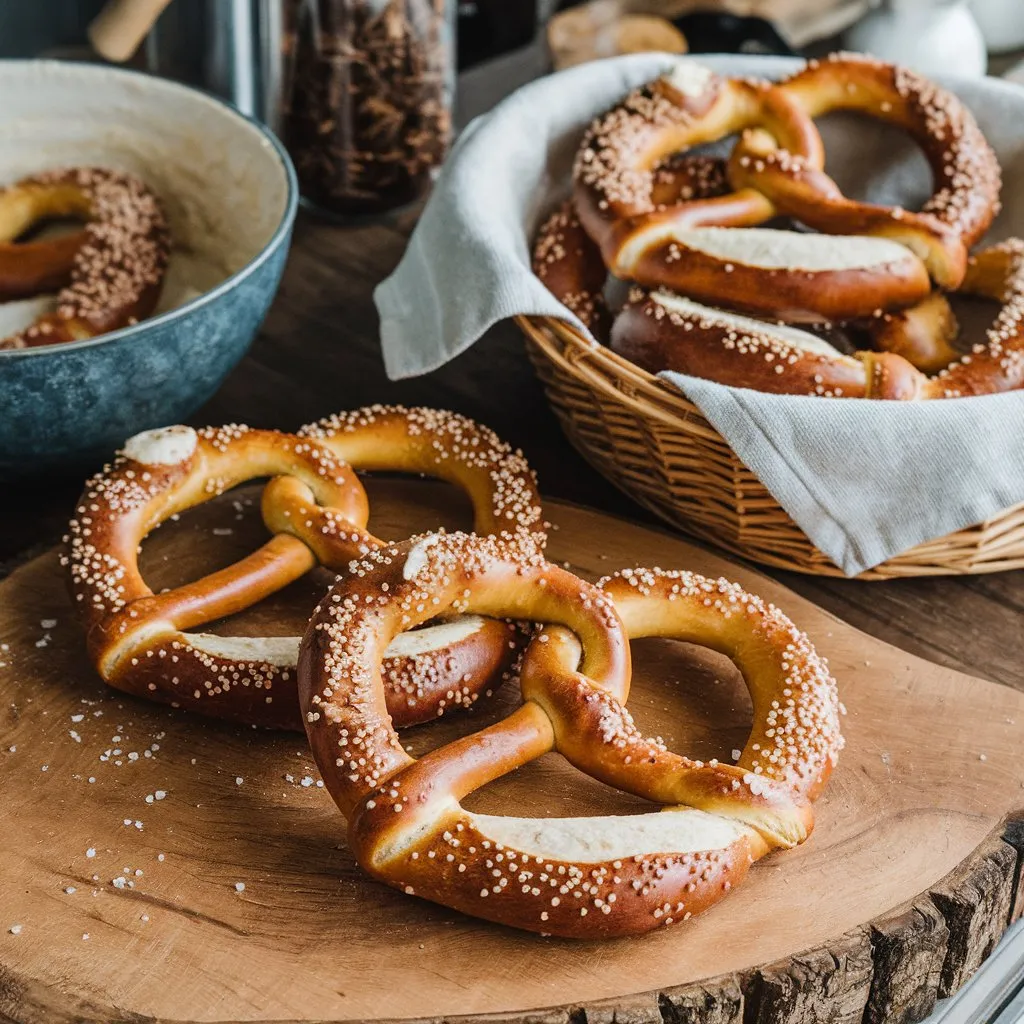
Origins and Etymology and Conclusion
The Brezel, known in English as the pretzel, has a rich history and etymology that reflect its cultural significance, particularly in Germany.
Origins
The origins of the pretzel date back to the early Middle Ages, around the 6th or 7th century. It is believed that European monks invented the pretzel, using its distinctive knot shape to symbolize the Holy Trinity, with the three holes representing the Father, Son, and Holy Spirit. This connection to religious practices helped embed the pretzel deeply into cultural traditions. Another theory suggests that the pretzel evolved from petiole, a type of Roman unleavened bread that was twisted and salted. By the 12th century, pretzels had become a recognizable symbol of German baking culture, often associated with bakers’ guilds. They gained further prominence when German immigrants brought their pretzel-making skills to other parts of Europe and America. During the 16th century, pretzels were sometimes given as rewards to children who learned their prayers, reinforcing their connection to religious customs. Over time, they became an integral part of German cuisine, enjoyed as both a savory snack and a festive treat on various occasions. The historical context surrounding the Siege of Vienna in 1683 adds another layer to the pretzel’s narrative. Viennese bakers are said to have played a crucial role in alerting defenders to Ottoman tunneling efforts during the siege. In gratitude for their vigilance, they created a special bread in the shape of the Ottoman crescent moon, which later evolved into what we know today as the croissant.
Etymology
The word “pretzel” comes from the German Brezel, which itself derives from the Middle High German bezel and Old High German brezitella. These terms are believed to originate from Vulgar Latin brachiātellus, a diminutive form of bracchiātus, meaning “with branches” or “arms.” This etymology reflects the appearance of the pretzel, which is often interpreted as resembling folded arms. The evolution of the term illustrates how language can reflect culinary traditions and cultural practices. The pretzel’s shape and its association with various meanings—such as arms folded in prayer—further emphasize its symbolic significance throughout history.
Conclusion
The Brezel/pretzel has evolved from its early religious symbolism into a beloved baked good with deep cultural roots in Germany and beyond. Its history intertwines with various traditions and events, making it not just a food item but also a representation of communal identity and heritage. Today, it remains a popular snack enjoyed worldwide, celebrated for its unique texture and flavor.
Ingredients
For the Dough
- 500 grams (4 cups) all-purpose flour
- 15 grams (1 tablespoon) brown sugar
- 30 grams (2 tablespoons) unsalted butter, softened
- 10 grams (2 teaspoons) sea salt
- 4 grams (1 packet) active dry yeast (about 1/2 packet)
- 275 milliliters (1 1/8 cups) lukewarm water
For the Lye Solution
- 12 grams of food-grade lye (or ½ cup baking soda as a substitute)
- 300 milliliters (1 1/4 cups) cold water
Topping
- Pretzel salt (coarse salt can be substituted)
Instructions
Step 1: Prepare the Dough
- Activate Yeast: In a bowl, combine lukewarm water, brown sugar, and yeast. Let it sit for about 5 minutes until it becomes frothy.
- Mix Ingredients: In a large mixing bowl, combine the flour and sea salt. Make a well in the center and pour in the activated yeast mixture along with the softened butter.
- Knead the Dough: Mix until combined, then knead the dough on a floured surface for about 8-10 minutes until smooth and elastic. Alternatively, use a stand mixer with a dough hook for about 5 minutes.
- First Rise: Place the dough in a lightly greased bowl, cover it with a damp cloth, and let it rise in a warm place for about 1 hour or until doubled in size.
Step 2: Shape the Pretzels
- Preheat Oven: Preheat your oven to 450°F (230°C) and line baking sheets with parchment paper.
- Divide Dough: After the dough has risen, punch it down and divide it into 8 equal pieces.
- Roll into Strips: Roll each piece into a long rope, about 20 inches long, tapering the ends slightly.
- Form Pretzel Shape: To shape each pretzel, form a U-shape with the rope, cross the ends over each other twice, then bring them down to attach to the bottom of the U.
Step 3: Prepare Lye Solution
- Make Lye Solution: If using lye, carefully mix food-grade lye with cold water in a well-ventilated area (wear gloves). If using baking soda, dissolve it in boiling water to create a baking soda bath.
- Dip Pretzels: Carefully dip each shaped pretzel into the lye solution or baking soda bath for about 20 seconds. Remove and let excess liquid drip off.
Step 4: Bake
- Sprinkle Salt: Place dipped pretzels on prepared baking sheets and sprinkle generously with pretzel salt.
- Bake: Bake in the preheated oven for about 12-15 minutes or until they are golden brown.
Step 5: Serve
- Remove from oven and let cool slightly before serving.
- Enjoy warm with mustard or cheese dip!
This recipe yields deliciously soft and chewy Brezeln that are perfect for snacking or serving at gatherings!
9. Rote Grutze Recipe
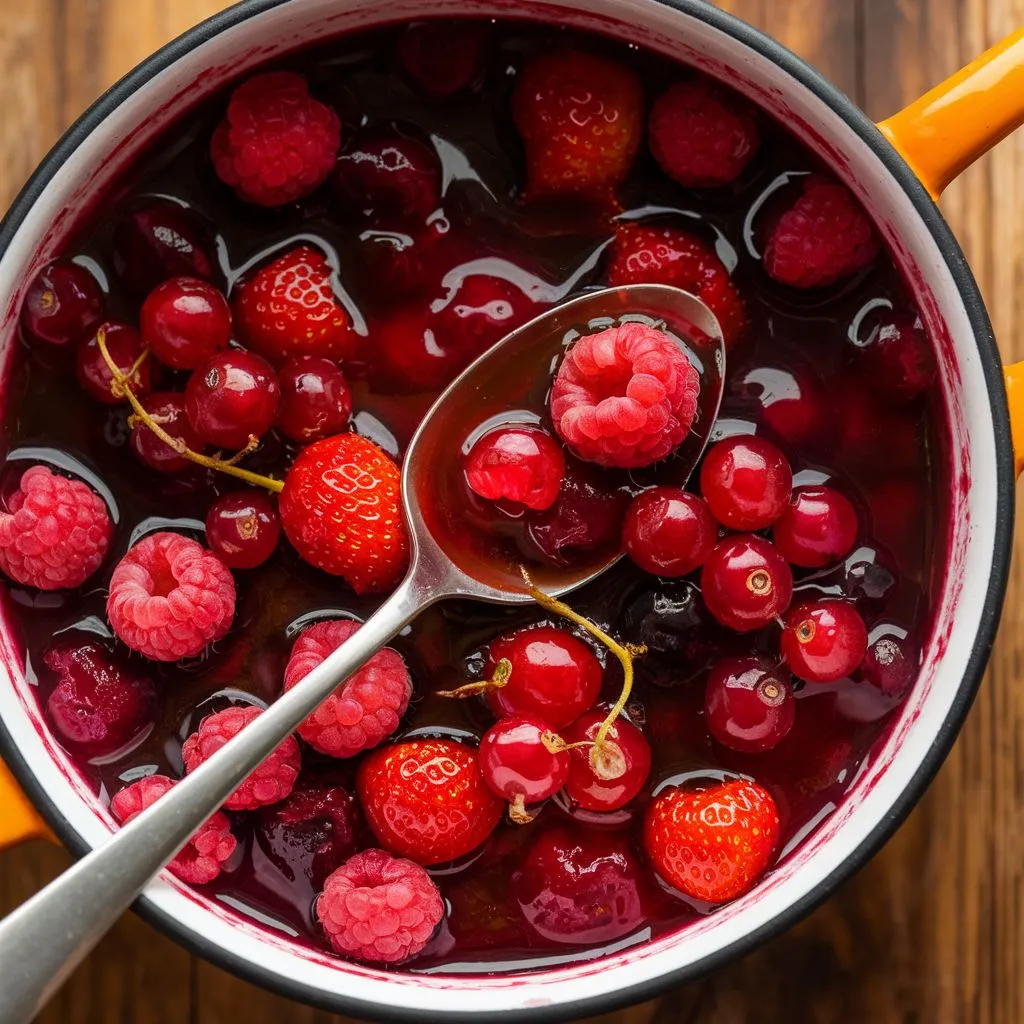
Origins and Etymology and Conclusion
Rote Grütze, a traditional German dessert, has a rich history and etymology that reflect its cultural significance, particularly in northern Germany.
Origins
Rote Grütze, which translates to “red gruel,” is a fruit dish primarily made from red berries, commonly red currants, raspberries, and strawberries. Its origins can be traced back to the 17th century when the first recipe was documented in a Schleswig-Holstein dictionary as “Roode Grütt.” Initially, it was prepared as a cereal porridge cooked in black currant juice and served with milk or cream
This dessert is particularly popular in northern Germany, with variations also found in Denmark, where it is known as Rødgrød. The exact origins of Rote Grütze are somewhat ambiguous, as both Germany and Denmark claim it as their own. It is thought to have evolved from a savory wheat porridge into the sweet pudding-like dessert we know today. Over the centuries, different recipes have emerged, contributing to the variety of preparations seen today.
Etymology
The name “Rote Grütze” derives from two German words: “rot,” meaning “red,” and “Grütze,” which translates to “groats” or “gruel.” The term Grütze refers to the starchy component traditionally used in the dish. In earlier recipes, coarse grains or groats were often used as thickening agents. Today, modern recipes typically utilize potato starch or cornstarch to achieve the desired pudding-like consistency. The dish’s name can evoke mixed feelings; while Grütze may sound unappealing to some (associating it with convalescent food), it is celebrated for its refreshing taste and vibrant color during summer months when fresh berries are in season.
Conclusion
Rote Grütze stands as a testament to northern German culinary heritage. Its evolution from a simple porridge to a beloved dessert reflects changes in ingredients and tastes over time. Today, it is enjoyed year-round, often served with vanilla sauce or cream, making it a delightful treat that continues to be cherished across generations.
Ingredients
- 500 grams (about 17.5 oz) of mixed berries (fresh or frozen; typically raspberries, red currants, strawberries, and optionally cherries)
- 300 ml (about 10 fl oz) water or fruit juice (like cherry or berry juice)
- 3 tablespoons sugar (adjust to taste)
- 30 grams (about 1 oz) cornstarch or potato starch
- 2 teaspoons vanilla extract
- Optional: 1 jar of sour cherries (about 680 g / 23 oz)
For Serving
- Vanilla sauce, whipped cream, or vanilla ice cream
Instructions
Step 1: Prepare the Berries
- If using fresh berries, wash them thoroughly. Remove stems and any pits from cherries. If using strawberries, cut them into halves or quarters if large.
Step 2: Cook the Berry Mixture
- In a saucepan, combine the mixed berries, water (or fruit juice), and sugar.
- Heat over medium heat until the mixture comes to a gentle boil, stirring occasionally.
Step 3: Thicken the Mixture
- In a small bowl, mix the cornstarch with a few tablespoons of cold water to create a slurry.
- Once the berry mixture is boiling, slowly pour in the cornstarch slurry while stirring continuously.
- Continue to cook for an additional 2-3 minutes until the mixture thickens. If it becomes too thick, you can add more water or juice to reach your desired consistency.
Step 4: Add Vanilla
- Remove the saucepan from heat and stir in the vanilla extract.
- If using sour cherries, add them at this stage.
Step 5: Cool and Serve
- Pour the Rote Grütze into serving bowls or a large dish and let it cool to room temperature.
- Refrigerate for at least 2 hours to set properly.
- Serve chilled or slightly warm with vanilla sauce, whipped cream, or vanilla ice cream.
Enjoy your homemade Rote Grütze! This refreshing dessert is perfect for summer and showcases the delightful flavors of red berries.
10. Stollen Recipe

Origins and Etymology and Conclusion
Stollen, a traditional German Christmas bread, has a rich history and etymology that reflect its cultural significance, particularly in the context of holiday celebrations.
Origins
The origins of Stollen can be traced back to the early 15th century in Germany, specifically in the region of Saxony. The first documented mention of Stollen as a Christmas bread occurred in 1474 when it was referred to in records from the Christian Bartholomäus Hospital in Dresden. Initially, Stollen was a simple bread made from flour, yeast, and water, as the Catholic Church’s fasting rules during Advent prohibited the use of richer ingredients like butter and milk. This resulted in a rather bland and hard pastry. In 1490, Elector Ernst of Saxony and his brother Duke Albrecht petitioned Pope Innocent VIII to allow bakers to use butter in Stollen. The Pope granted this request through a document known as the “Butter Letter,” which permitted the use of butter and other fine ingredients like raisins and almonds for baking Stollen, albeit with some penance required. This marked a significant turning point in the evolution of Stollen, transforming it from a tasteless bread into a rich and flavorful treat. By the 16th century, Stollen became an integral part of Christmas celebrations in Dresden. The bakers would present large Stollen to their rulers during festive occasions, with one notable tradition dating back to 1560 when bakers gifted their ruler with Stollen weighing up to 36 pounds.
Etymology
The word “Stolen” is derived from the Middle High German word stolle, which means “post” or “support.” This term likely refers to the shape of the bread, which resembles a mound or a loaf supported by its structure. Additionally, some interpretations suggest that the shape symbolizes the swaddled baby Jesus, reflecting its connection to Christmas traditions. The term Striezel, an earlier name for Stollen, is also significant; it referred to a type of elongated yeast pastry that was common in medieval times. Over time, Striezel evolved into Stollen, further solidifying its identity as a festive bread associated with Christmas celebrations.
Conclusion
Stollen has evolved from its humble beginnings as a simple fasting bread into a beloved symbol of Christmas in Germany and beyond. Its rich history is intertwined with religious practices and cultural traditions that have shaped its recipe over centuries. Today, Stollen is enjoyed worldwide during the holiday season, celebrated for its flavorful combination of dried fruits, nuts, spices, and often marzipan. The Dresdner Stollen, in particular, has gained protected status under European law, ensuring that this iconic bread continues to be made according to traditional methods in its region of origin.
Ingredients
For the Dough
- 500 grams (4 cups) all-purpose flour
- 75 grams (1/3 cup) granulated sugar
- 10 grams (2 teaspoons) salt
- 25 grams (2 tablespoons) active dry yeast
- 250 ml (1 cup) whole milk, warmed to about 110°F (43°C)
- 150 grams (2/3 cup) unsalted butter, melted and cooled
- 1 large egg
- 1 teaspoon ground cinnamon
- 1 teaspoon ground nutmeg
- Zest of 1 lemon
- Zest of 1 orange
For the Filling
- 200 grams (about 1 cup) mixed dried fruits (such as raisins, currants, and chopped dried apricots)
- 100 grams (about 1/2 cup) candied orange peel
- 100 grams (about 1/2 cup) blanched almonds, chopped
- Marzipan (optional, about 100 grams)
For Topping
- Melted butter for brushing
- Powdered sugar for dusting
Instructions
Step 1: Prepare the Dough
- Activate Yeast: In a small bowl, combine warm milk, a pinch of sugar, and the yeast. Let it sit for about 5-10 minutes until frothy.
- Mix Dry Ingredients: In a large mixing bowl, whisk together the flour, sugar, salt, cinnamon, nutmeg, and citrus zests.
- Combine Ingredients: Make a well in the center of the dry ingredients. Add the melted butter, egg, and activated yeast mixture. Mix until combined.
- Knead the Dough: Transfer the dough to a floured surface and knead for about 10 minutes until smooth and elastic. Alternatively, use a stand mixer with a dough hook for about 5 minutes.
Step 2: First Rise
- Place the kneaded dough in a lightly greased bowl. Cover with plastic wrap or a damp cloth and let it rise in a warm place for about 1 to 2 hours or until doubled in size.
Step 3: Prepare the Filling
- While the dough is rising, soak the mixed dried fruits in warm water or rum for about 30 minutes to plump them up. Drain before using.
- If using marzipan, roll it into a log shape about the length of your Stollen.
Step 4: Shape the Stollen
- Once the dough has risen, punch it down and turn it out onto a floured surface.
- Flatten the dough into a rectangle about 12 inches long.
- Spread half of the soaked dried fruits, candied orange peel, and chopped almonds evenly over the dough.
- If using marzipan, place it in the center of the filling.
- Fold one side of the dough over to cover the filling partially and then fold over again to create an oval shape with one side slightly higher than the other to form a hump.
Step 5: Second Rise
- Place the shaped Stollen on a baking sheet lined with parchment paper. Cover with a cloth and let it rise again for about 45 minutes to an hour.
Step 6: Bake
- Preheat your oven to 350°F (175°C).
- Bake the Stollen for about 30-40 minutes or until golden brown and an internal thermometer reads about 190°F (88°C).
- Remove from oven and immediately brush with melted butter.
Step 7: Cool and Serve
- Allow the Stollen to cool completely on a wire rack.
- Once cooled, dust generously with powdered sugar before serving.
Enjoy your homemade stolen! This delightful bread is perfect for sharing during festive occasions and can be stored for several weeks when wrapped properly.
